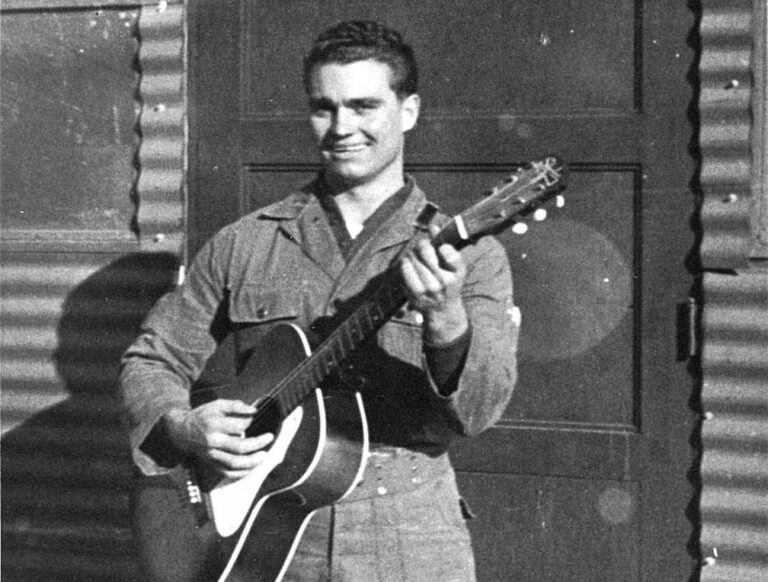When discussing the names of legendary country performers of the mid-20th century, chances are the name Leroy Van Dyke doesn’t immediately come to mind.
Van Dyke didn’t have a lot of hits, but two of his songs that DID make the charts have become synonymous with country music. Those hits spurred a career that is now in its eighth decade.
Leroy Van Dyke was born in Missouri, the son of farming parents. In fact, his entire extended family was involved in the agriculture industry.
During his youth, the music business never entered Van Dyke’s mind as a potential career. He attended the University of Missouri, majoring in agriculture and agriculture journalism, later working for the Chicago Tribune.
But during his college days, Van Dyke picked up the guitar for the first time and taught himself to play. He quickly discovered his tenor voice could really belt out a tune, and he started writing songs.
One of those, based on his family’s life in agriculture, became a hit upon its release as Van Dyke’s first ever recording. In fact, it became so popular that during his tenure in the military, serving as a soldier in Korea, he was invited to open Marilyn Monroe’s USO show.
“The Auctioneer”
“The Auctioneer,” released on country radio as a single in 1956, tells the story of a boy from Arkansas whose life goal is to become a cattle auctioneer.
Something about the fast-talking auctioneers appealed to the youngster, and he escaped to the cattle yards whenever he could to listen and mimic the auctioneers’ calls. Much to his mother’s chagrin, the boy dropped out of school to pursue his dream, practicing auction cries both day and night.
When the boy’s father hears the boy practicing, he’s less than impressed. “Son,” he said, “we just can’t stand to have an ordinary man selling things at auction using our good name.” So, he sends the boy off to auction school, where he excels.
Ultimately, he reaches the top of his profession “and the people would come from miles around just to hear him make that rhythmic sound that filled their hearts with such a happy cheer.” Soon, the boy’s name spreads nationwide, and he’s known as the best auctioneer in the land.
“The Auctioneer” isn’t autobiographical, although Van Dyke did spend some time in the profession. Rather, he dedicated the song to a cousin who was a well-known auctioneer in the Missouri area. Van Dyke does display some of his own “calling” abilities throughout the song as it is interspersed with fictional auction cries.
The lyrics are a bit hard to follow, but one interlude, in effect, is as follows. I challenge you to say this three times fast (or if you’re up to Van Dyke’s standards, try memorizing and singing it untold thousands of times).
Twenty-five dollar bid’ja now, thirty dollar, thirty wudja make it thirty bidda onna thirty dollar thirty dollar wouldja gimme, wouldja give me thirty dollar bill? I gotta thirty dolla bidja, now, five, wouldja beedle onna thirty-five biddle on a thirty-five, thirty-five? Who’s gonna bitta the thirty-five dollar bill?
“The Auctioneer” rose to No. 9 on the U.S. Country charts and remained Van Dyke’s only recording for nearly five years.
After his military service ended, Van Dyke returned to agriculture journalism and worked for newspapers in the Midwest. But he didn’t forget his fledgling music career. He appeared on the television show “Ozark Jubilee” on a regular basis and performed on Chicago’s WGN radio. In 1961, Van Dyke headed for Nashville, where he signed with Mercury Records.
“Walk on By”
One of Van Dyke’s first releases with Mercury Records was the title song of his first-ever album, “Walk on By.” The song, with lyrics lending itself to one of country music’s early “cheating” songs, shot to No. 1 on the charts and stayed there for an astounding 19 weeks. After that, it remained at various levels on the charts for nearly an entire year.
“Walk on By” surpassed “The Auctioneer” as Leroy Van Dyke’s signature song, selling 1.5 million copies and even hitting No. 5 on the pop charts.
The song had lasting appeal and was played on country radio for decades to come. In fact, in 1994, Billboard Magazine ranked “Walk on By” as the biggest song in country music history based on chart performance and sales.
Think about it.
A relative unknown outside of country music beat out the multitude of recordings from the likes of Hank Williams, Patsy Cline and Ray Price for the most popular country song of all time. The song also garnered a Grammy for Van Dyke and led to his invitation to perform on the Grand Ole Opry a year later.
Eight decades in the business
The rest of Leroy Van Dyke’s performing career has been long — but largely forgettable
Other than a follow up hit to “Walk on By,” Van Dyke never again appeared in the Top 10, languishing in the depths of the charts with most of his releases. Many of his singles were covers of those of other artists. However, he did have a final minor hit in 1977 with “Texas Tea.”
Despite his limited success, Van Dyke made a career of the few hits he recorded.
He never again opened for the likes of Marilyn Monroe. However, he appeared at countless fairs, festivals, auctions, rodeos and conventions. He also became a minor draw in Branson, Missouri, where country music fans flock to hear artists whose songs no longer appear on the charts.
Today, at the age of 95, he still performs on occasion. There’s no word if he ever flexes his vocal cords to call an auction.
Nearly 70 years after its release, “The Auctioneer” still receives occasional airplay. While some may consider it a novelty song, it has outlasted many other hits of its age.
Whether “The Auctioneer” or “Walk on By” holds sway as Van Dyke’s signature song is up to the listener. “Walk on By” has been covered by numerous other artists over the decades, but with “The Auctioneer,” Van Dyke virtually remains in a class of his own.
Until next time, auctioneering isn’t as popular as it once was in the U.S., so if you aspire to cry out, “I just sold that pig for a 50-dollar bill!” I suggest you don’t quit your day job.
To read more of Kris Rutherford’s Rhythm of the Road content, click here.
Since retiring from a career as an outdoor recreation professional from the State of Arkansas, Kris Rutherford has worked as a freelance writer and, with his wife, owns and publishes a small Northeast Texas newspaper, The Roxton Progress. Kris has worked as a ghostwriter and editor and has authored seven books of his own. He became interested in the trucking industry as a child in the 1970s when his family traveled the interstates twice a year between their home in Maine and their native Texas. He has been a classic country music enthusiast since the age of nine when he developed a special interest in trucking songs.













